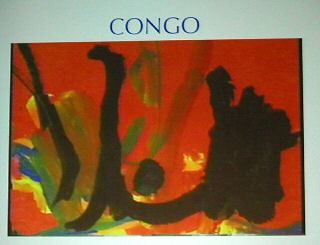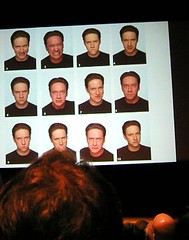Saturday, January 15, 2005
Empathy in the Brain and in Art
The 4th International Conference on NeuroestheticsUC Berkeley Art Museum, 15 January 2005-01-15
This morning I joined three hundred neuroscientists and students in the theatre at the U.C. Berkeley Art Museum for an all-day symposium on empathy and art.
Intro
Ulterior motive: bringing art and science together
Interest in Neuroesthetics heating up (a dozen hits on Google last year; now 2,000)
Today our focus will be empathy, a fundamental aspect of human communication
Intentional Attunement: From mirror neurons to Empathy
Vittorio Gallese, from the Dept of Neuroscience at the University of Parma, got things off to a great start.Whenever we observe, predict, or hear the consequences of an action, "mirror neurons" energize our brains the same as if we were actually doing something. Looking at the face of a disgusted person activates the disgust area of the observer’s brain. Same deal looking at a picture of someone being touched. To some extent, this even works when presented with a merely symbolic representation of an action. We do not just “see” the actions, emotions and sensations of others. We and they share an intelligible interpersonal space, a “we space.”
"Nature is on the inside," said Cézanne. Quality, light, color, depth awaken an echo in our brains. "It is the artist who is truthful, the photo mendacious," said Rodin.
It becomes impossible to distinguish between who is seeing and what is being seen. (You've heard this meme here before.)
When Bill Clinton says "I feel your pain," maybe he does.
More information on this here.
The Art of Face - a Mask, a Body, a Movement
Leonard Pitt, Writer and Movement ArtistEmpathy is about listening (and Leonards’s teacher taught Marcel Marceau). He's into mime. Interesting how people mediate their experience. What we say about face holds true for body. He’s watched feet from Paris cafés. For days. The great whoosh of experience. You take it in, not analyze in it.
Masks. Masks just like people. Picks up tragedy mark, dons beret. Takes labored breathe. Looks around. Something grabs attention. Mime time. Recognition. Pained breath. Sad contemplation. Uncertainty. Head bent down. Frozen mask but shows: pride, anger, etc. All this from a sad mask. He’s moving in space forward, back.
Mr. Happy. Smug. Mischief. Trickster. He dons the mask. His eyes open wide. Laughter. There’s always laughter. It’s recognition that the eyes match the mask, and that’s enjoyable. Yawn. Backache.
The feet are the proletariat of the body: they are always carrying the weight. People often forget to express the lower part of their body. “I’m just showing people what they already know but they just don’t know it.”
When people are new to masks, they think they’ve got to move all over. Finally they realize that slower is better. “The best dancers don’t move.”
He talks about about the persona of a character behind the mask. He’s Dropo, the retired French clown of Italian parentage. He puts on a clown hat...and looks exactly the same. He puts on his nez…mon nez... Je l’appelle Claude. Claude Monet.
Cultural Teachings from the Apes
Frans B.M. de Waal, Professor, Department of Psychology, Emory UniversityCulture was once reserved for humans: “Culture is that complex whole which includes knowledge, belief, art, law, morals, customer and many other capabilities and habits acquired by man”. Culture, like the soul, was not for animals. Then Shigery Watanabe (1995) found that pigeons could discriminate between Matisse and Picasso. The bower bird does art. Kinji Imanishi (1952) on Koshima island found cultural transmission among monkeys. One monkey began washing her potatoes. Within a decade all individuals (except the mature males) washed their potatoes. They wasn't any teaching. This was imitation. They aped one another.
Cats don’t paint. Congo, the premiere painting monkey, does. Knows when a painting is complete & won’t continue. There’s no figurative art and no interest in the end product.

If you didn't think animals have culture, wake up and smell the coffee.
Recognizing the Subtleties in Facial Expressions
Paul Ekman. University of California, San FranciscoYou've read about this guy. He identified the emotions that occur in every culture. (Or at least the 23 he has looked into.) These include seven negative emotions...

- Anger
Fear
Sadness
Disgust
Happiness
Surprise
Contempt
- 5 sensory pleasures
Amusement
Excitement
Relief
Wonder
Ecstasy
Fiero – I get it!
Naches – from parenting
Schadenfreude
My raw notes contain more detail and describe a few other speakers.
Two days later, Monday: This event was sufficiently out of my traditional boundaries that I can almost feel my brain making connections as it incorporates what I heard into what I already knew. On yesterday's walk, I listened to Barry Schwartz on my mp3 player. Speaking at PopTech, he was railing against our being confronted with too many choices. Clueless undergraduates entering college are presented hundreds of classes to choose from. This is bewildering. Worse, they're so divided that they can't learn from dialog with other students. It's early and my thoughts are wandering. I'm all for freedom but know that we each have to get out of our comfort zones, to push the envelope; until this form of daring becomes a habit. For example, speakers of English will be better learners if they are force-fed some Milton, Yeats, Pound, Frost, and Jeffers, and forced to watch Citizen Kane, A Man and a Woman, and Ken Burns' The Civil War.









0 Comments:
Post a Comment
<< Home